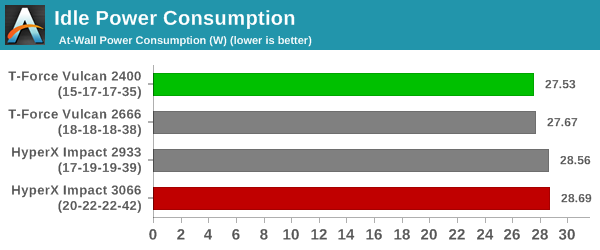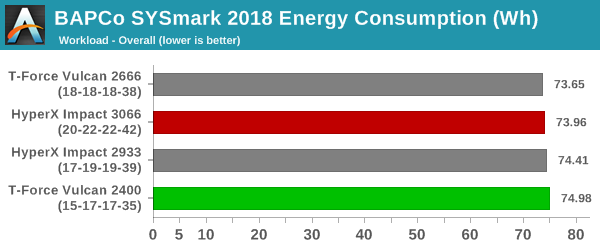Memory Frequency Scaling in SFF Systems: An Investigation with SO-DIMMs and Coffee Lake
by Ganesh T S on November 28, 2018 8:00 AM ESTFinal Words
Improvements in memory bandwidth and reductions in latency are the performance benefits provided by the usage of high-performance SO-DIMM kits. In the previous pages, we looked at the performance of four different SO-DIMM configurations in a SFF desktop PC. Power / energy consumption is one of the last remaining aspects to consider.
In addition to performance, idle power consumption is also an important metric – particularly for usage in battery-constrained systems such as workstation notebooks. The higher the DRAM operating frequency, the greater the power consumption. Some high-frequency kits use 1.35V (instead of the 1.2V standard), which tends to drive up the power consumption further. Fortunately, all our tested configurations had SO-DIMMs that operated at 1.2V.
To get a full view of the impact of different memory kits on this aspect, we monitored the power consumed at the wall by the ASRock DeskMini Z370 GTX with an idle desktop and averaged it over a duration of 1 hour.

As expected, the higher-frequency operating points consumer more power, but not by a huge margin. While considering the above graph, it is also helpful to keep in mind the energy consumption for typical workloads. Kits that help get work done faster may consume less energy compared to the kits that consume less power even during operation.

Coming to the business end of the article, it is clear that the choice of memory is dictated by the expected workloads. For most common workloads, the differences between DDR4-2400 and DDR4-3066 are minimal. However, there are cases where the memory characteristics can play a significant role - 7-Zip compression is a real-world example where the kits with lower latencies deliver better compression rates.
For the average user who keeps the system idle most of the time, it is probably better to save money and have lower idle power in the long run. On the other hand, power users who keep their systems busy may want to opt for kits that deliver low latencies (and, in the case of some workloads, just higher speeds).
| DRAM Options for the ASRock DeskMini GTX (Z370) | |||
| Memory Kit | Tested Frequency (MT/s) |
Tested Timing (tCL-tRCD-tRP-tRAS-tRFC) |
Price (USD) |
| Kingston HyperX Impact HX432S20IB2K2/16 |
3066 | 20-22-22-42-560 | $168 |
| 2933 | 17-19-19-39-514 | ||
| Team Group T-Force Vulcan TLRD416G2666HC18FDC-S01 |
2666 | 18-18-18-38-467 | $130 |
| Team Group T-Force Vulcan TLRD416G2400HC15BDC-S01 |
2400 | 15-17-17-35-421 | $130 |
Our tests have also shown that a higher speed-grade kit is not necessarily better – the HyperX Impact DDR4 operating at 2933 MT/s has the best latency numbers. It edges out the same kit operating at 3066 MT/s with different timing parameters in almost all of the benchmarks. Conversely, the Team Group T-Force Vulcan SO-DIMMs offer good value for money and can boast of better idle power characteristics.











25 Comments
View All Comments
cygnus1 - Wednesday, November 28, 2018 - link
How does anyone look at those memory benchmarks and justify buying anything other than the cheapest RAM that meets minimum spec?Yuriman - Wednesday, November 28, 2018 - link
Pretty much agree. Good to know, though.nwrigley - Wednesday, November 28, 2018 - link
Yep. The only difference for me is that I only buy Crucial. This comes from personal experience of AMAZING customer support from them.I had one of their sticks die on me once after 8 years of use. I called in and was shocked to talk to someone in the US. Since they didn't make the same RAM I had anymore, they offered to replace all 4 sticks so that I had a matching set, even though 3 of the 4 sticks were fine. And since the replacements were slower timings without heat spreaders, they offered to double the capacity to cover the difference. They upgraded me from 4x 1-gig sticks of DDR2 to 4x 2-gigs of DDR2 without me raising any fuss - this was all customer services idea. That made me a customer for life.
cygnus1 - Wednesday, November 28, 2018 - link
Yeah, I too am a big Crucial fan because of reasons like this, from my experience as well. Not quite as generous as your story, but never any kind of trouble getting support for their hardware.But these benchmarks really show that performance should not be even remotely near the top of the list of reasons to pick one RAM part over another. Brand/warranty/customer service is a real way to differentiate and justify a given price.
koaschten - Wednesday, November 28, 2018 - link
I found this handy graphic on reddit some time ago:https://i.imgur.com/lbPIkiW.png
Looking at the tested offerings, it is obvious why there was so little performance gain, the Latency/clock relations are just off the chart, for the 3066 CL20 literally.
koaschten - Wednesday, November 28, 2018 - link
source: https://www.reddit.com/r/intel/comments/9mlwbn/ram...yes, this is DIMM not SO-DIMM, but shows the differences nicely.
willis936 - Wednesday, November 28, 2018 - link
It is somewhat frustrating to see all of this work done on a case that doesn't make sense to examine first.If the original question is "When does memory performance matter to CPUs?" then the place to start is at the extreme, not somewhere in the middle. If it was found that an 8 core 4 GHz x86 processor with whatever cache architecture and two channels of memory was memory bandwidth or latency starved THEN it would make sense to start moving down the stack and identify when it is no longer a concern. The conclusion to draw from this is much less meaningful to most any reader. There are like five people on the planet choosing between more expensive and cheaper memory kits for SFF systems.
GreenReaper - Thursday, November 29, 2018 - link
Might make more sense with AMD APUs. You'd probably get a much better return from overclocking the memory than the CPU, given how bandwidth-starved they can be.The_Assimilator - Wednesday, November 28, 2018 - link
Whatever happened to ranking memory by its performance rating, to determine how objectively good it is? For anyone who doesn't know/remember, performance rating = (memory frequency / CAS latency), and higher = better.It's sad that in this day and age, my 2x8GB DDR3-1600 CL8 (with no RGB LEDs or unnecessary heatsinks) has a higher PR than any of these DDR4 kits. It's even sadder that today's reviews of memory that "overclock" it, just concentrate on pushing up the frequency instead of trying to tighten the CAS timings, because the latter is where you'll see the most benefit.
nevcairiel - Wednesday, November 28, 2018 - link
All you are calculating here is the actual latency, since CAS latency is expressed in cycles. What this doesn't account for is the actual memory speed (ie. bandwidth).Just using your formula, a 1600/8 and 3200/16 module should be equal, right? But one of those offers twice the raw memory throughput, at about similar absolute latency (ie. performance rating).
It is a good idea to keep in mind that latency and frequency interact, but not in a way you suggest. Many people look at things like 3200 CL16 and 3600 CL18 and would instinctively say that the second set has a higher latency, while in reality the actual latency is quite similar, and you get more bandwidth.